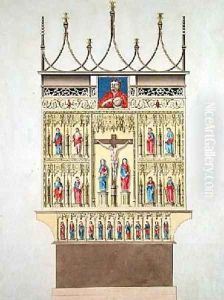Heinrich Wilhelm Julius Koch Paintings
Heinrich Wilhelm Julius Koch was a German painter and lithographer, primarily recognized for his landscape paintings and his contribution to the development of lithography in the 19th century. He was born in 1802 in Germany, although the exact location of his birth is not widely documented. Throughout his career, Koch was influenced by the Romantic movement, which was prevalent in Europe during his lifetime.
Koch's landscapes often reflected the Romantic era's emphasis on the beauty and power of nature, depicting scenes that evoked emotion and grandeur. His works frequently portrayed the German countryside, with a focus on the accuracy of geological features and a keen observation of atmospheric effects. This attention to detail and his ability to capture the mood of a scene made his paintings resonate with audiences of his time.
In addition to his painting, Koch was an early adopter and practitioner of lithography, a printing process that was invented at the end of the 18th century. Lithography allowed for the mass production of images and was particularly suited to the reproduction of artworks. Koch became skilled in this technique, which enhanced his ability to disseminate his works to a broader public, thus contributing to the popularization of lithographic prints.
Throughout his career, Koch exhibited his works at various art venues and gained a certain amount of recognition for his contributions to German art. However, despite his talents, he did not achieve the same level of fame as some of his contemporaries. He passed away in 1867, leaving behind a body of work that continued to be appreciated by art historians and collectors interested in the German Romantic landscape tradition and the development of lithography.

